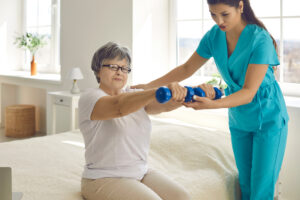“When do I get to go home?” This is the number 1 question I get asked as an Inpatient Rehab Therapist. Even more than…”When will I get better?” Most patients that have been in the hospital for a period of time get anxious about returning home.
It’s something about getting back to your cozy environment, sleeping in your own bed, and being around your family and friends, pets, and own personal belongings that make this the number 1 goal for patients. However, an Inpatient Rehabilitation Facility is a facility that is designed to prepare patients for the process of returning home.
In my previous blog The Top 5 Benefits of Inpatient Rehabilitation (LINK), I briefly discuss the process by which healthcare providers determine when it’s safe for a patient to discharge home. In addition, it is just as important for patients and families to prepare themselves for discharge home as well.
Considering the circumstances surrounding hospitalization, there will definitely be lifestyle changes that need to be considered. In this article, I will detail ways in which you or your loved one can prepare for discharge planning from acute care physical therapy, in the hospital, and around the home.
IN THE HOSPITAL
#1 PARTICIPATING IN FAMILY TRAINING
There are several ways that patients can prepare to discharge home from the hospital, one of which is participating in a family training session. This is particularly useful for patients who require some level of assistance with mobility-related activities.
A family training session can be scheduled by either a therapist or case manager and can involve several healthcare professionals including physical therapists (PT), occupational therapists (OT), speech therapists (SLP), and nursing staff.
Property of Rehaballey.com
The goal of a family training session is to inform and teach family, and/or potential caregivers how to safely manage the patient while at home. Family/friends that will be assisting the patient at home are first contacted, and then a session is scheduled based on the family/caregivers’ availability.
Once a family training session has been scheduled, family and/or caregivers will be expected to arrive at the hospital, during the scheduled time, to start their training.
A family training session can last between 30 minutes to an hour and can include multiple sessions with different healthcare professionals. Therefore, plan to stay at the hospital for about half a day to complete these sessions.
This is also a very good time to address any concerns that you or your loved one may have about discharging home. You will also be given a lot of valuable information, so it is a good idea to take some notes as well.
A typical family training session with a Physical Therapist may include mobility and tasks such as:
- Transfers
- Sit-to-stand transfers
- Car/vehicle transfers
- Transfers in/out of bed
- Transfers up and down curbs or steps
- Walking-(If applicable)
- Wheelchair mobility/management-(if applicable)
- Fall Recovery Strategies
- Home Exercise Program
- Community Reintegration
In addition, Occupational Therapy may focus on ADL tasks such as:
- Upper and lower body dressing
- Grooming
- Feeding
- Bathing
- Transfers
- In/out of shower or tub
- On/off the toilet
- Use of adaptive equipment (links)
Speech Therapy typically focuses on training related to:
- Cognitive deficits
- Issues relating to swallowing difficulties
- Thickened food/liquids
- Modified food textures
- PEG tube feeding (if applicable)
The nursing staff will typically base their training on:
- Medication Management/Schedule
- Managing bowel and bladder
- Colostomy bags
- Catheters
- Wound care management- if not already addressed by a healthcare provider.
- Dressings
- Gauze
- Bandaging
- Wound Vac- (If applicable)
If it is determined that oxygen will be required while at home, then a healthcare provider will start the process of ordering oxygen prior to discharge.
Property of Rehaballey.com
**ALLEY TIPS: Most rehab facilities will do their best to wean you off of oxygen, or to eliminate as many lines and tubes as possible prior to discharge. If not, be sure to schedule training with the appropriate hospital personnel**
**ALLEY TIPS: It is also important for family/caregivers to attend some patient therapy sessions to keep current on the patient’s progress**
#2 ORDERING DURABLE MEDICAL EQUIPMENT

This is another very important way that patients and families can prepare for discharge home. Some facilities may even postpone discharge until all necessary equipment has been ordered and/or received on the day of discharge. Therefore, it is very important to prepare for this process ahead of time.
In most cases, either the therapist or case managers will order equipment, as long as it is covered under the patient’s insurance. The equipment will then be delivered to your room prior to discharge. In some cases, however, the insurance company may not cover certain durable medical equipment or adaptive equipment.
The therapist can then give their recommendation on what is needed, and then it will be up to the patients and/or caregivers to order this equipment on their own time. You can refer back to my All Products tab at rehaballey.com (LINK) to get an idea of which equipment therapists typically recommend for home.
Property of Rehaballey.com
Certain companies have different options and/or prices that may or may not fit your budget; therefore you should always do your research prior to ordering. If you or your loved one do not have insurance and are unable to pay out-of-pocket for equipment, then you can ask your case manager or therapist about charity options.
#3 PLANS FOR CONTINUING THERAPY
Another great way that patients and families can prepare for discharge home is to know your options and plans for continuing therapy. Most patients that have gone through the rehabilitation process still may need to continue therapy in order to reach their full potential. Some options for continuing therapy can include:
-Outpatient Rehabilitation
-Long-term Acute Care
-Skilled Nursing Facility
The latter of the two #3, #4 are recommended for patients who are unable to return home safely. These various options are discussed in a weekly team conference meeting consisting of doctors, nurses, therapists, and case managers. Once a decision by the medical team has been made, then the patients and families are informed of the decision and can either agree or disagree with the discharge placement.
IN THE HOME
#1 PREPARING THE HOME ENVIRONMENT

There are also ways that patients and family members can prepare for discharge home from the hospital by preparing their home environment. The most common concern that I’ve seen as a therapist for patients returning home, tends to be steps and stairs.
A majority of patients have at least one step that they have to manage at home. Some of these steps are encountered outside of the house and can be a difficult task for patients. Depending on a patient’s physical and medical status, steps and stairs may not always be feasible. For example, if a patient is non-ambulatory, and/or wheelchair-bound, then other options for entering the home will have to be considered.
Property of Rehaballey.com
The best option for patients to avoid steps/stairs if they are physically unable is to have a ramp built. This process, however, can take quite a bit of time; therefore starting this process early is very crucial. For those that do not have the time or finances to have a ramp built, a portable ramp can be purchased for temporary use. Feel free to visit my website https://rehaballey.com/mobility-equipment-and-accessories/ (LINK) to get my recommendation on a portable ramp.
Patients may also encounter steps/stairs inside the home as well. In most cases, a therapist will be able to work with the patient on how to manage steps/stairs prior to their discharge home. Depending on the patient’s functional capabilities, this may not always be the safest option. Other options to consider may include sleeping downstairs or having a stairlift device installed.
**ALLEY TIPS: Other options to consider for patient safety on steps/stairs include installing handrails (preferably on both sides of the steps) for support. And installing light switches on the top and bottom of the steps. If you have wooden steps, it will be beneficial to place non-slip treads on the steps to reduce the likelihood of slipping and falling**
Another major issue that I see for patients and families when discharging home are tight spaces around the house. The bathroom is usually the most commonplace for tight spaces. For patients and/or families that encounter tight spaces inside their home, my top suggestion would be to try to create as much space as possible by removing objects and obstacles from the walking path.
If you still encounter tight spaces, then take measurements of the doorways, bathroom, and any other areas and show them to either your therapist or case manager during your next visit or scheduled family training session. The therapist can help patients and families come up with strategies on how to maneuver through tight spaces in their homes.
Property of Rehaballey.com
** ALLEY TIPS: It is also important to measure the size of the durable medical equipment that you will be using at home, in order to get the proper fit for your home.**
Other things to consider to prepare for discharge from a rehabilitation facility include:
- Noting and measuring the height of your bed at home.
- Measuring the height of your vehicle ie: vehicles that are too small or too large tend to be very difficult to transfer in and out of. I found that SUVs tend to be a good size for patients to discharge home in.
- Consider using a step if your vehicle is too high, or using a pillow in your seat if the height is too low. Feel free to view my website link https://rehaballey.com/rehabilitation-vitals-and-accessories/ for my recommendation on steps.
- Remember: Most patients will need to get clearance from their doctor or surgeon before they can start driving again, after an acute illness or injury.
- Place commonly used items in a place that can be easily reached
- Remove throw rugs out of the walking path. I discuss the dangers of throw rugs in my blog post Falls in the elderly risk factors and preventions.
When encountering barriers around the home, I recommend taking a video or pictures of your home to show your therapist and/or case manager. This visual will help your therapist tailor sessions more specific to your needs.
In closing, preparing for discharge from an Inpatient Rehabilitation Facility is a very important step in the rehab process. Hopefully, this article helps to make this process smoother for you and your family. GOD BLESS YOUR ENDEAVORS!!





